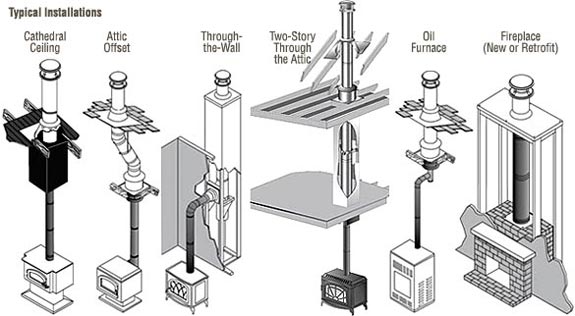Jun 15th 2020
Chimney Installation Types
Through the Roof installation
Through the roof venting systems run straight up and down and terminate through the roof. Because the ideal chimney is one that runs straight up from the stove through the center of the house and out the roof, with no elbows or bends, venting vertically through the roof is beneficial if you are willing to cut holes in the ceiling and roof to perform the installation. A straight up and down chimney system allows flue gases to follow one route instead of passing through bends and elbows which could restrict flue gas flow and affect draft.
Things to Consider
- Venting through the roof uses black stove pipe which is considerably less than class A chimney pipe.
- Through the roof venting chimney systems produce less draft.
- A roof vented chimney system doesn't have elbows or bends that will restrict draft or air flow.
- Keeping the chimney venting system on the inside of the house creates warmer flue temperatures and less draft.
- Black stove pipe radiates heat so the more you keep inside of your house, the better.
- A roof venting chimney system is easier to clean.
Through the Wall installation
through the wall vent would be shaped horizontal or on an angle that is perpendicular to the fireplace. This particular installation involves placing a hole in the side of your home in order to allow the installation of a stove pipe. As the fireplace is in use and is burning fuel and other materials, the fumes and exhaust from the fire are drafted through the wall and up. The best location for chimneys for optimum performance and draft is on an interior wall of the house. An exterior chimney is subject to cold outdoor temperatures, leading to greater heat loss and higher rates of creosote accumulation and moisture condensation in the chimney.
Things to Consider
- Through the wall venting chimney system offer a little more versatility for installation options.
- Through the wall venting chimney systems will spare your ceiling and roof from having holes cut in them.
- Venting through the wall can be done from the ground where it's safe as opposed to on the roof.
- Venting through the wall requires class A chimney pipe which is more expensive than black stove pipe.
- Bends like the 90 degree tee and any connector elbows in a chimney restrict flue gas flow and affect draft.
- A horizontal venting chimney system is harder to clean.


